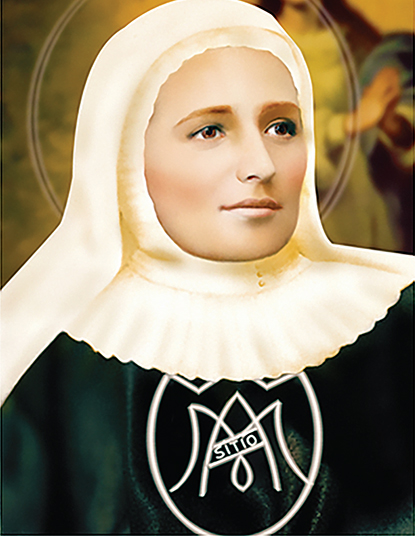
Missionary of Mercy
Monday, May 2, 2016
*Rogelio Zelada
The long and tiring journey through the region of Uribá had ended happily. On foot and by mule, seven brave women and a poor native who served as their guide and laborer have finally reached Dabeiba. To achieve this they have opened paths through the thick wall of the tropical jungle, defying restless rivers, facing unknown places, sweltering weather, and dangerous animals. They have reached the heart of the Colombian jungle to teach the Gospel and catechize the indigenous, with the simple weapons of their humble testimony and their kind dedication to the most marginalized of their time.
Laura Montoya Upegui has not been defeated by the prejudice and limitations of a Church and a society that did not look kindly upon a group of single women embarking on this missionary adventure "like wild goats," going into lands seemingly forgotten by God.
Laura Montoya was born May 26, 1874, in Jericó, a town in the southwestern part of Antioquía Department in Colombia. The youngest of three siblings, she soon experienced the destruction of her household: when Laura was just two years old, her father, a defender of the weak, renowned believer, doctor and reputable merchant, was murdered. All the family assets were looted and the family was left in utter helplessness.
Like St. Francis, poverty was Laura’s constant companion. Through the efforts of a relative she managed to enter a school for wealthy girls in Medellín, but was not welcomed there. She went to live in an asylum where an aunt worked as director. Thanks to a scholarship, she would graduate as a teacher in 1893. She taught at several campuses until she became director of a prestigious Catholic school, which had to be closed because of a vicious smear campaign organized by a well-known anticlerical writer.

St. Laura Montoya: Missionary of Mercy
Pope Pius X’s encyclical, Lacrimabili status Indorum, which called on the bishops of Latin America to remedy “the deplorable condition of the Indians in Lower America," was the spark that finally ignited Laura Montoya’s passion, the urgency of her mission among the natives of her Colombian homeland. With an intelligence well ahead of her time, Laura Montoya did not share the view of those who thought "that catechesis should begin by making the indigenous get rid of the parumato wear pants, forget their original language and replace it with Spanish, destroy their huts and live in houses, to force them by a mandate or martial discipline to leave their traditions and customs to adopt what they see with horror in those who are more or less responsible for causing the near total ruin of their race. This, beyond impossible, is cruel."
The passion of this woman for the evangelization of the indigenous collided again and again with the indifference of some important prelates and the lack of vision of women's religious congregations that she tried to recruit for this missionary work. They were not ready or willing to work in the inhospitable jungles of Uribá.
So Laura conceived a new model of religious community, one willing to meet the indigenous, the blacks and the marginalized on their level; willing to live like them, to share in their world every day, always guided by charity; deriving strength from the witness of shared poverty, simplicity and the kindness of a humble life; intending to reap no benefits but making itself available to the least of their brothers and sisters.
Laura goes in search of other women who want to share in the ideal of being "missionary catechists to the indigenous." She gathers five other missionaries and completes the group with her own mother who, though still strong, was 78 years old. To pay for this first venture, she makes and sells crafts, necklaces, mirrors and all she can get. Providentially, she has the approval of the bishop of Santa Fe de Antioquia, who offers support and financial assistance.
After setbacks and difficulties, they leave from Medellín to the jungle, which they reached May 14, 1914. The indigenous, used to dealing with abuse from white people, did not know what to expect from those women who had “fallen from the sky.” However, the mission gradually started to bear fruit when they saw how the women not only came to instruct them in the Christian faith but, above all, to treat them as equals, as human beings with the right to dignity and respect. In so doing, the missionaries inconvenienced many bosses who could no longer abuse the indigenous by seizing their land.
After a while, the bishop advised the missionaries to become a religious community with the name of Missionary Sisters of Mary Immaculate and St. Catherine of Siena. From that moment on, Laura Montoya became Mother Laura of St. Catherine of Siena.
Mother Laura breaks all the pre-established models that circumscribed the work of religious women in Latin America. She proves that they can take initiatives to encourage the social and religious elevation of indigenous people; that femininity is not an obstacle but a treasure for bringing the Gospel to the poor.
The religious women become firmly integrated in the way of life of those whom they evangelize, although it is not easy for city people to adapt to the loneliness and inherent dangers of the jungle. Mother Laura goes to Uré, where an old native tells her, "There are many souls who do not know anything at all about God." There she establishes another house in an old building offered by the bishop of Santa Rosa de Osos. She then travels to the region of Sarare, and that is how the congregation expands not only within greater Colombia, but also into Ecuador and Venezuela, ultimately reaching 19 countries in three continents.
A prolific writer, Mother Laura received the Cross of Boyacá in the category of Caballero, awarded by the President of the Republic in 1939.
She extends her charism to blacks and mestizos who live poorly on the river banks, isolated and abandoned by the Church as well. She establishes missionary homes to care for them, despite tremendous hardship and suffering caused by the attitude of some priests and bishops who are disinclined to offer spiritual help to these small mission homes maintained by the sisters.
Mother Laura died October 21, 1949 at age 75, having spent nine of them in a wheelchair, her body swollen and ulcerated, beset by very intense pain, but with enough energy to console the sisters and everyone who came to visit.
St. John Paul II proclaimed her Blessed in 2004; Benedict XVI announced her canonization, which was celebrated in 2013 by Pope Francis in St. Peter's Square and attended by a large delegation of the Colombian government, headed by the President of the Republic.
St. Laura Montoya is the first canonized daughter of the Colombian people; from the glory of heaven, she continues to invite us, in the words of Pope Francis, “to make the joy of the Gospel radiate through our words and in the witness of our life, wherever we find ourselves.”

